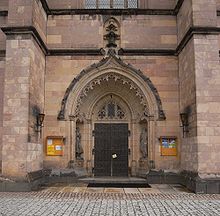Schloßbergmuseum Chemnitz
The Schloßbergmuseum is the museum of local history of the city of Chemnitz . It is located in the Schloßchemnitz district on the site of an old Benedictine monastery , which Emperor Lothar III. around 1136 on a mountain near Chemnitz .
history
The monastery “St. Marien “existed for almost 400 years and was repeatedly rebuilt. The last reconstruction in the late Gothic style took place between 1488 and 1522 under the penultimate abbot Heinrich von Schleinitz . The monastery was disbanded as one of the consequences of the Reformation . Around 1540 the Benedictines left the building that fell to the Saxon Elector . Some of the former monks who wanted to stay were allowed to leave the order and live there for life. The former abbot Hilarius took over the property management until 1546. He was followed by the electoral clerk Barthel Lauterbach . Extensive renovations were initiated by Lauterbach under Moritz , the building became an area administration and hunting lodge .
At the beginning of the 18th century the buildings went into private ownership. Due to its charming location, it developed into a popular excursion destination with a beer garden and bowling alleys .
In 1928 the city of Chemnitz left the palace to the “Verein für Chemnitz History”, founded in 1872, as an exhibition space for the association's collection after extensive restorations. In 1931 the new city museum was opened.
In 1945, the castle church suffered bomb damage to the neo-Gothic spire , the roof and the north facade. Damage repair and simplified tower closure took place from 1946 to 1949, the restoration of the interior from 1950 to 1957. All other facilities survived the Second World War almost undamaged, but were closed in 1979 due to pending renovation work.
It was not until 1995 that the Chemnitz City Museum reopened its doors after a redesign under Thomas Schuler .
Selected exhibits
Holy grave
As Holy grave are cenotaphs Christ referred. In the Schloßbergmuseum Chemnitz there is a holy grave from the city church of St. Jakobi , which is modeled after a Gothic cathedral. It was made around 1500 for the Jakobikirche. There are sculptural figures standing on consoles on it : Joseph of Arimathäa , Nicodemus , Maria , her sister Maria Cleophae , Maria Magdalena and the two apostles Johannes Evangelista and Peter . The figures on the corner consoles have not been preserved. In addition, the body of Christ is missing , which was equipped with movable arms and legs so that he could be symbolically crucified , removed from the cross and buried. This was probably originally mobile and could on its location, probably in one of the side rooms, on the occasion of Kar - liturgy are drawn into the church main room.
Epitaph of the captain Peter Pfefferkorn
Peter Pfefferkorn was an active captain in the middle of the 16th century , who was ennobled by Emperor Charles V because of his services in the Turkish Wars. His epitaph is one of the art-historically significant Renaissance sculptures in the Free State of Saxony . It consists of Chemnitz porphyry tufa and shows peppercorn in a full-figure relief as a field captain. The plate is 180 cm high, 97 cm wide and 22 cm deep. Pfefferkorn is depicted as a confident, bearded, old man in armor. At the bottom right at his feet is the detached visor helmet with a plume . The figure emerges from a round arch designed as a relief with Renaissance ornament. The left hand reaches for the dagger hanger , the right leans on the sword pommel . At the top left of the “portal” is the coat of arms of the deceased, which shows an eagle , a crescent moon and three stars with a crest , thus referring to his elevation to the nobility.
In terms of its importance in terms of urban and art history, the work is comparable to the record by Mayor Matthes Arnold . The good quality of the sculpture should also be emphasized here, which indicates an above-average sculptor. In terms of style, comparisons can be made with the grave slab of Thomas Pflugk in the Laurentiuskirche in Pegau and that of Andreas Pflugk in Knauthain , which also shows a full-length "knight figure" with a visor helmet at its feet. Art historical research therefore mostly ascribes the work to the sculptor and builder Paul Speck from the Electoral Saxony .
Web links
- Website of the Schloßbergmuseum. In: schlossbergmuseum.de
Individual evidence
- ^ The Benedictine monastery in Chemnitz (Schloßberg). History. In: tu-chemnitz.de, accessed on March 4, 2018.
- ↑ Heinrich Magirius in: Fates of German Architectural Monuments in the Second World War. A documentation of the damage and total losses in the area of the German Democratic Republic. Volume 2: Districts Halle, Leipzig, Dresden, Karl-Marx-Stadt, Erfurt, Gera, Suhl. Ed. And edit. by Götz Eckardt. Henschel-Verlag, Berlin 1978, OCLC 989590393 , p. 453.
- ^ Erich Brandenburg (Ed.): Political correspondence of the Duke and Elector Moritz von Sachsen. Vol. 5: January 9, 1551 - May 1, 1552. Edited by Johannes Herrmann and Günther Wartenberg (= treatises of the Saxon Academy of Sciences in Leipzig , Philological-Historical Class. Volume 68.5). Akademie Verlag, Berlin 1998, ISBN 3-05-003086-0 .
Coordinates: 50 ° 50 ′ 42.2 " N , 12 ° 54 ′ 54.5" E



